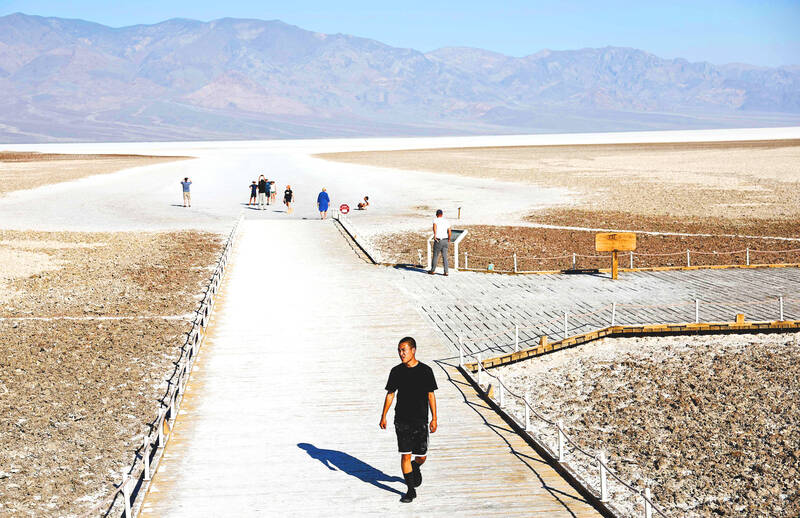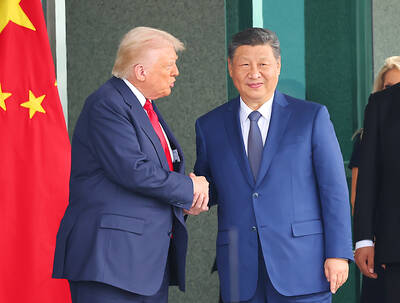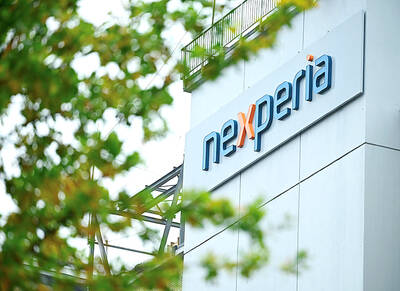At a laboratory in a Southern California warehouse, scientist Heng Su unveils what could be a world-changing solution to the global water crisis.
The small handheld object looks unremarkable, consisting of stacked white fins that resemble a miniature old-fashioned apartment radiator, but when Su puts the device on a scale, it silently gains weight within seconds. As the minutes pass, it gets heavier and heavier. That is because the gadget is invisibly gathering water molecules from the surrounding air.
Nearby, four of the water harvesters sit inside a plastic enclosure shaped like a transparent birdhouse. The warm air inside dislodges the water molecules from the harvesters and a condenser transforms the water vapor into liquid, which is dripping into a beaker.

Photo: AFP
The technology, called metallic organic frameworks (MOFs), does not require electricity and can produce water with just ambient sunlight. It is Irvine-based start-up Atoco’s vision for how to provide water in an increasingly arid world.
This is a lab prototype designed to only produce a few milliliters of water as scientists work to perfect the technology. The company plans on building a full-scale commercial version that could produce thousands of liters of ultrapure water a day for a community. A unit the size of a residential air-conditioner could supply water to people’s homes.
“You can harvest water from air anywhere in the world, at any time of the year regardless of the level of humidity, without a carbon footprint,” said Omar Yaghi, who founded Atoco in 2021, pioneered MOFs and is a chemistry professor at the University of California, Berkeley.
Half the world’s population experiences water scarcity and 25 percent endure extremely high levels of water stress, a UN analysis found this year.
Even in a wealthy area such as California, which boasts the world’s fifth-largest economy, nearly 1 million residents lack access to clean drinking water, a June report found.
Meanwhile, climate change-fueled heat waves and droughts are exacerbating water shortages across the world, sparing neither rich nor poor, and more intense and frequent storms can knock water treatment plants offline.
Yet even the driest skies contain water.
The US Geological Survey has estimated that the atmosphere contains 12,900 cubic kilometers of water, or about 14 percent of what is found in the world’s lakes.
MOFs offer a unique way to harvest some of it. Like Doctor Who’s TARDIS, the material is bigger on the inside. A gram of MOFs can have the surface area of a soccer field.
Imagine you take a piece of paper and crumple it as much as you can. It is now a fraction of its original size, but retains the same surface area within the folds, Atoco CEO Samer Taha said.
That is what Atoco is doing on a molecular level — engineering nanoscale crystalline structures filled with porous cavities. Its MOFs are made of elements that attract specific molecules, such as water.
The company cooks up its MOFs in a small room off the main lab at its headquarters. There, an amber liquid boils in a beaker next to a centrifuge that reduces it to a fine powder. This is where chemists are creating organic “linker” molecules, which connect metallic molecules and provide stability to the MOF’s crystalline structure.
The inorganic molecules form cavities that serve as microscopic water tanks for water molecules drawn from the atmosphere. The first water molecules that attach themselves to the insides of the cavities become “seeds” to which others bind.
MOFs are made from mostly common elements such as carbon, nitrogen, hydrogen, copper and aluminum.
However, some of the specialized molecules Atoco needs can be expensive due to their scarcity, and its scientists are working to synthesize them in-house in an effort to drive down costs, Taber said.
In an adjacent room, several barrels sit on the floor. Senior scientist Jacob Kanady opens the lid on one, which is filled with a white powder made from identical nanoscale crystalline structures. When a binder is added, the powder solidifies so it can be fashioned into fins for the lab water harvester.
Conventional methods of harvesting water from the atmosphere rely on cooling the air until water vapor liquifies, a process that consumes large amounts of electricity. It is also not effective in environments with low humidity. Another option for producing water in arid regions, desalinization, requires immense energy, affects marine life and leaves behind brine waste.
MOFs sidestep those obstacles, producing purified water on site using no or little electricity. They are, in Yaghi’s view, a transformational technology.
“For the first time in human history, you can modify materials on the atomic and molecular level and you can design them with precision to be suitable for a particular application,” he said.
Other start-ups are developing MOFs for atmospheric water harvesting.
However, Atoco has an edge: Yaghi developed the material and has continued to perfect it while working in a field known as reticular chemistry.
“The advances that professor Yaghi has made over the past decade keep us ahead of the competition,” Taha said.
He declined to say when Atoco would bring its technology to market, but said: “It’s not far.”
The challenge Atoco and its competitors face is developing cost-effective processes to mass-produce MOFs, said Laura Gagliardi, a professor of chemistry and molecular engineering at the University of Chicago who has collaborated with Yaghi.
Atoco declined to comment on the price to make its MOFs at scale, but said that the company is on track to harvest water for US$0.01 or less per liter.
“I worked with these people long enough to understand that this technology works very well, and it has been demonstrated in the field,” Gagliardi said.
In August 2022, Yaghi and University of California, Berkeley colleagues tested a prototype of a handheld water harvester in California’s Death Valley National Park, one of the hottest, driest places on the planet. At night, the harvester adsorbed water molecules from the atmosphere. During the day, they were released as the sunlight warmed the harvester and a condenser then liquified the water vapor.
With temperatures at ground level hitting 60°C and an average humidity of 14 percent, the harvester produced 118ml to 207ml of water a day, said a paper the scientists published in the journal Nature Water last year.
Although it is not nearly enough to serve an average person’s daily needs, it illustrates the promise of the technology.
Water from air could be a game changer for increasingly arid and impoverished regions of the world where desalinization is not an option and conventional atmospheric water harvesting is ineffective due to low humidity.
Traditional harvesters also collect air pollution along with water vapor, requiring the captured water to be purified at additional expense. MOFs, on the other hand, are engineered to capture only water molecules, filtering out contaminants and producing water free of nanoplastics, perfluoroalkyl and polyfluoroalkyl substances chemicals and other toxics.
“Initially, we are focusing all our efforts on tackling water scarcity and trying to operate in arid conditions, which is actually our competitive advantage because we can harvest water even in dry conditions, while others cannot,” Taha said.
Atoco is designing water harvesters that need only sunlight to operate or that can be powered by renewable energy. That would allow a harvester to operate when the sun is not shining, as well as employ fans to draw more molecules into the MOFs, producing more water in the process.
The US military has boosted such efforts by establishing an Atmospheric Water Extraction program. In 2020, the US Defense Advanced Research Projects Agency (DARPA) awarded a US$14 million grant to General Electric Co (GE) to develop MOF technology that could supply water to troops, and the company enlisted Yaghi and Gagliardi to advise and work on the project.
“The electrified device that GE is now delivering to DARPA is delivering 22 liters of water per day, using only 2kg of MOFs,” Gagliardi said. “So I think that this is all very promising.”
In March, GE Verona, a spinoff of GE’s energy business, announced a joint venture with start-up Montana Technologies called AirJoule to commercialize the technology. AirJoule has developed an MOF atmospheric harvester that also provides energy efficient air-conditioning through evaporative cooling.
One of AirJoule’s innovations is to tap the heat generated by the adsorption of water molecules to extract them for condensation. A proprietary vacuum compressor and condenser transforms the water vapor into liquid.
Two big potential markets for AirJoule’s atmospheric harvesting technology are the US military, which must truck water to troops deployed in remote locations, and rapidly expanding data centers, which consume staggering amounts of water and electricity for cooling and have become flashpoints in drought-stricken regions, Montana Technologies CEO Matt Jore said.
“Data centers are not getting permitted, because of water consumption, so we have a huge opportunity,” he said.
The cost of the MOFs Montana Technologies uses has fallen from US$5,000 per kilogram to less than US$50 per kilogram, Jore said.
The company has built preproduction models of the machine and intends to begin manufacturing the devices next year for the air-conditioning market.
While AirJoule sees specific industries as potential customers, Taha is thinking bigger.
The market is anyone “that wants to have a consistent, stable and pure water supply and doesn’t want to rely on water coming from the government,” he said.

RUN IT BACK: A succesful first project working with hyperscalers to design chips encouraged MediaTek to start a second project, aiming to hit stride in 2028 MediaTek Inc (聯發科), the world’s biggest smartphone chip supplier, yesterday said it is engaging a second hyperscaler to help design artificial intelligence (AI) accelerators used in data centers following a similar project expected to generate revenue streams soon. The first AI accelerator project is to bring in US$1 billion revenue next year and several billion US dollars more in 2027, MediaTek chief executive officer Rick Tsai (蔡力行) told a virtual investor conference yesterday. The second AI accelerator project is expected to contribute to revenue beginning in 2028, Tsai said. MediaTek yesterday raised its revenue forecast for the global AI accelerator used

Taiwan Semiconductor Manufacturing Co (TSMC, 台積電) has secured three construction permits for its plan to build a state-of-the-art A14 wafer fab in Taichung, and is likely to start construction soon, the Central Taiwan Science Park Bureau said yesterday. Speaking with CNA, Wang Chun-chieh (王俊傑), deputy director general of the science park bureau, said the world’s largest contract chipmaker has received three construction permits — one to build a fab to roll out sophisticated chips, another to build a central utility plant to provide water and electricity for the facility and the other to build three office buildings. With the three permits, TSMC

TEMPORARY TRUCE: China has made concessions to ease rare earth trade controls, among others, while Washington holds fire on a 100% tariff on all Chinese goods China is effectively suspending implementation of additional export controls on rare earth metals and terminating investigations targeting US companies in the semiconductor supply chain, the White House announced. The White House on Saturday issued a fact sheet outlining some details of the trade pact agreed to earlier in the week by US President Donald Trump and Chinese President Xi Jinping (習近平) that aimed to ease tensions between the world’s two largest economies. Under the deal, China is to issue general licenses valid for exports of rare earths, gallium, germanium, antimony and graphite “for the benefit of US end users and their suppliers

Dutch chipmaker Nexperia BV’s China unit yesterday said that it had established sufficient inventories of finished goods and works-in-progress, and that its supply chain remained secure and stable after its parent halted wafer supplies. The Dutch company suspended supplies of wafers to its Chinese assembly plant a week ago, calling it “a direct consequence of the local management’s recent failure to comply with the agreed contractual payment terms,” Reuters reported on Friday last week. Its China unit called Nexperia’s suspension “unilateral” and “extremely irresponsible,” adding that the Dutch parent’s claim about contractual payment was “misleading and highly deceptive,” according to a statement